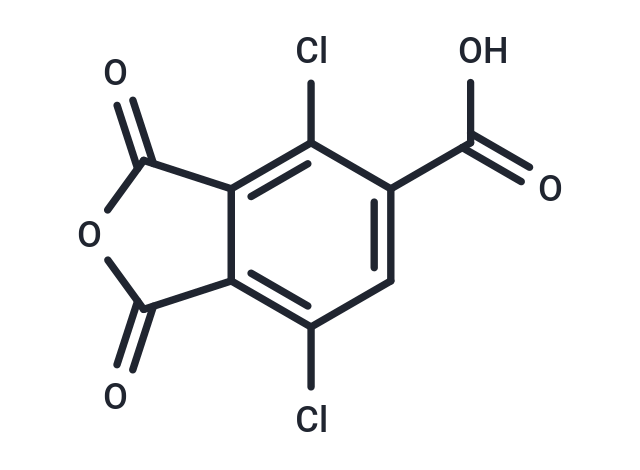Shopping Cart
Remove All Your shopping cart is currently empty
Your shopping cart is currently empty
3,6-Dichlorotrimellitic anhydride serves as the essential precursor in the synthesis of various dichlorinated fluoresceins and rhodamines.

| Pack Size | Price | USA Warehouse | Global Warehouse | Quantity |
|---|---|---|---|---|
| 10 mg | $38 | In Stock | In Stock | |
| 25 mg | $61 | In Stock | In Stock | |
| 50 mg | $89 | In Stock | In Stock | |
| 100 mg | $132 | In Stock | In Stock | |
| 200 mg | $195 | In Stock | In Stock | |
| 1 mL x 10 mM (in DMSO) | $29 | In Stock | In Stock |
| Description | 3,6-Dichlorotrimellitic anhydride serves as the essential precursor in the synthesis of various dichlorinated fluoresceins and rhodamines. |
| Cell Research | Instructions I. Solution preparation 1. Stock solution: Dissolve 3,6-Dichlorotrimellitic anhydride in an appropriate solvent, such as anhydrous DMSO or DMF, to prepare a stock solution with a concentration of 1–10 mM. 2. Working solution: Dilute to an appropriate working concentration, usually 1–10 µM, using an experimental buffer (such as PBS, pH 7.4) according to experimental requirements. II. Experimental steps 1. Synthesis of chlorinated fluorescein or rhodamine derivatives 1) React 3,6-Dichlorotrimellitic anhydride with an appropriate aminofluorescein or rhodamine molecule, usually in an anhydrous solvent. 2) Reaction conditions: The reaction is usually carried out at 50–70°C for 2–6 hours. 3) After the reaction, purify using an appropriate solvent (such as methanol or water) to remove unreacted raw materials and by-products. 2. Labeling oligonucleotides or DNA 1) Label the target oligonucleotide or DNA with synthetic dichlorofluorescein or rhodamine derivatives. 2) Labeling is usually performed by covalent bonding, using chlorofluorescein or rhodamine to react with the amino or carbamate groups of nucleic acids. 3) Reaction time: Incubate at 4°C for 1–2 hours. After the reaction is completed, purify the labeled DNA or oligonucleotide using gel electrophoresis or liquid chromatography (HPLC). 3. Calibration and control 1) Control group: Use unreacted fluorescent dye or labeled DNA as a control to ensure the specificity of the labeling reaction. 2) Standard curve: Use a known concentration of labeled DNA sample to establish a standard curve between the fluorescence signal and the concentration. Notes 1) Photosensitivity: Synthetic chlorofluorescein and rhodamine derivatives are usually highly photosensitized. Avoid strong light exposure during the experiment to prevent the fluorescence signal from attenuating. 2) Storage conditions: 3,6-Dichlorotrimellitic anhydride and synthetic fluorescent markers should be stored at -20°C, away from light. 3) Solubility: 3,6-Dichlorotrimellitic anhydride may release chlorine gas when dissolved, and the experiment should be performed in a well-ventilated area. " |
| Molecular Weight | 261.02 |
| Formula | C9H2Cl2O5 |
| Cas No. | 81742-10-1 |
| Smiles | OC(=O)c1cc(Cl)c2C(=O)OC(=O)c2c1Cl |
| Relative Density. | 1.877 g/cm3 (Predicted) |
| Color | White |
| Appearance | Solid |
| Storage | keep away from direct sunlight | Powder: -20°C for 3 years | In solvent: -80°C for 1 year | Shipping with blue ice/Shipping at ambient temperature. | |||||||||||||||||||||||||||||||||||
| Solubility Information | DMSO: 55 mg/mL (210.71 mM), Sonication is recommended. | |||||||||||||||||||||||||||||||||||
Solution Preparation Table | ||||||||||||||||||||||||||||||||||||
DMSO
| ||||||||||||||||||||||||||||||||||||
| Size | Quantity | Unit Price | Amount | Operation |
|---|

Copyright © 2015-2026 TargetMol Chemicals Inc. All Rights Reserved.